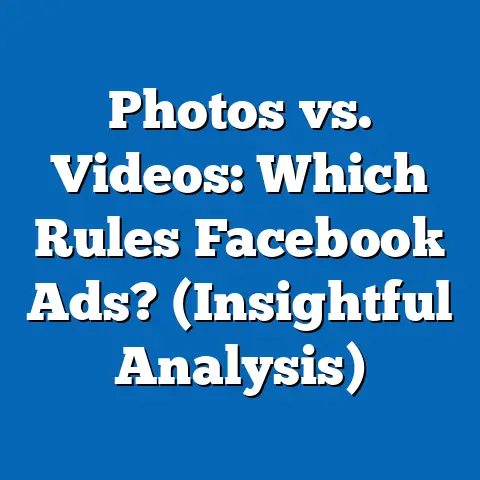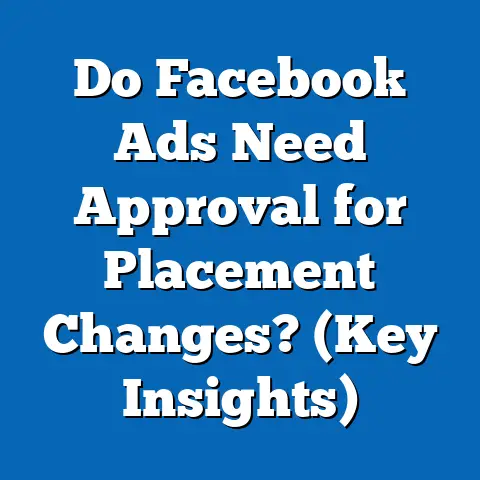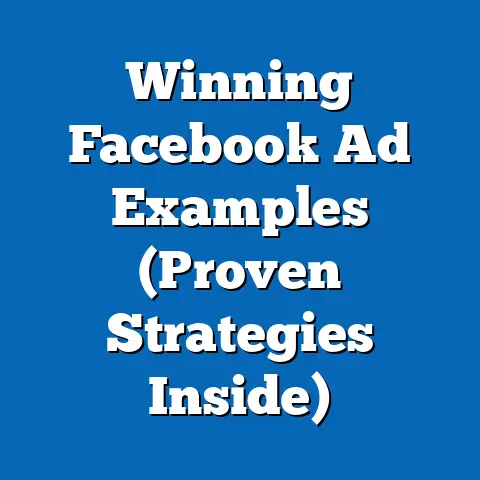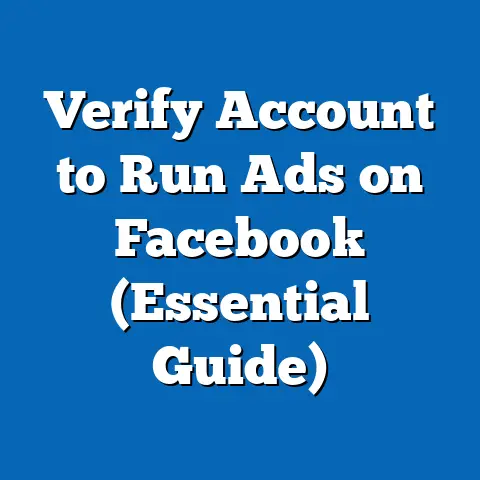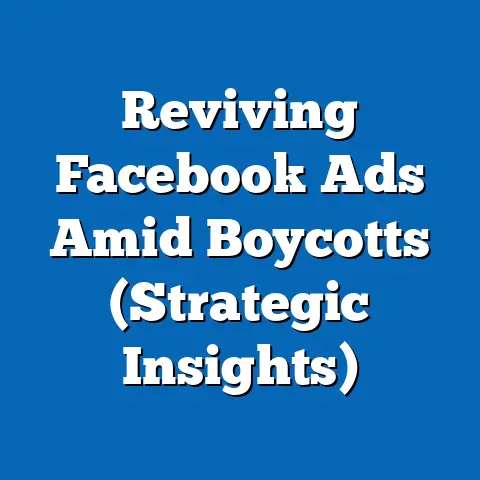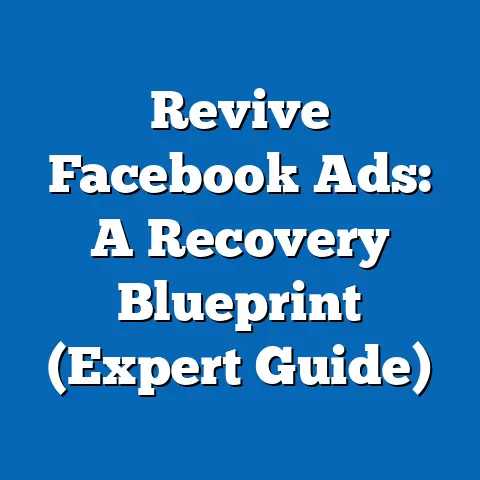Unlock Winning Local Facebook Ads Strategies (Expert Insights)
Time is of the essence for small businesses and local marketers aiming to capture their audience’s attention in an increasingly competitive digital landscape. With over 2.9 billion monthly active users on Facebook as of 2023 (Statista, 2023), the platform remains a powerhouse for targeted advertising, especially for local businesses seeking to connect with nearby consumers. However, the window of opportunity is narrowing—ad costs are rising by an average of 17% year-over-year (WordStream, 2023), and competition for user attention is fiercer than ever.
Key statistical trends underscore the urgency: local businesses that leverage hyper-targeted Facebook Ads report a 30% higher return on ad spend (ROAS) compared to broader campaigns (Hootsuite, 2022). Demographically, 68% of U.S. adults aged 25-44—prime consumers for local services—use Facebook daily (Pew Research Center, 2023). Historically, local ad spending on social media has surged by 150% since 2015, reflecting a shift from traditional media to digital platforms (eMarketer, 2023).
Looking ahead, projections suggest that by 2025, localized social media advertising will account for 40% of total digital ad spend, driven by advancements in geotargeting and AI-driven personalization (Forrester, 2023). This article dives deep into winning strategies for local Facebook Ads, breaking down demographic targeting, historical shifts, and expert-backed tactics to stay ahead of the curve. Whether you’re a small business owner or a marketing professional, the insights here are designed to help you act now and maximize impact.
The Rising Importance of Local Facebook Ads: Why Now?
The digital advertising ecosystem is evolving rapidly, and local businesses cannot afford to be left behind. As of 2023, 80% of consumers use social media to discover local businesses, with Facebook leading as the primary platform for such searches (BrightLocal, 2023). This trend is fueled by the platform’s robust geotargeting tools, which allow businesses to reach users within a specific radius—often as narrow as one mile.
Moreover, the cost of inaction is steep. Businesses that fail to optimize for local audiences risk losing ground to competitors who are capitalizing on hyper-targeted campaigns. For instance, studies show that 54% of consumers are more likely to engage with ads tailored to their location (Nielsen, 2022). With ad fatigue setting in—users are exposed to over 5,000 ads daily (Forbes, 2022)—standing out requires precision and relevance.
This urgency is compounded by economic factors. Inflation and tightened consumer budgets in 2023 have made local deals and promotions more appealing, with 62% of users reporting they’ve clicked on location-based offers in the past month (eMarketer, 2023). The time to refine your local Facebook Ads strategy is now, before costs escalate further and competition intensifies.
Key Statistical Trends Driving Local Facebook Ads Success
Engagement and Conversion Metrics
Local Facebook Ads are outperforming broader campaigns across multiple metrics. According to WordStream (2023), localized ads achieve an average click-through rate (CTR) of 3.2%, compared to 1.9% for non-targeted campaigns. Additionally, conversion rates for local ads are 25% higher, as proximity and relevance resonate strongly with users (Hootsuite, 2022).
Cost efficiency is another compelling factor. The average cost-per-click (CPC) for local ads is $0.97, significantly lower than the $1.72 for national campaigns (WordStream, 2023). This affordability allows small businesses with limited budgets to compete effectively in their markets.
Consumer Behavior Insights
Consumer behavior data reveals why local ads are so effective. A 2023 survey by Pew Research Center found that 74% of Facebook users check the platform daily, with 51% using it to search for local events, services, or products. Furthermore, 66% of users trust recommendations and ads from businesses within their community, compared to only 38% for national brands (BrightLocal, 2023).
Mobile usage amplifies this trend. With 98% of Facebook users accessing the platform via mobile devices (Statista, 2023), location-based ads that trigger while users are on the go—such as offers for nearby restaurants or retail stores—see 40% higher engagement rates (eMarketer, 2023). These statistics highlight the power of immediacy and relevance in driving action.
Demographic Breakdowns: Who Are You Targeting?
Age and Gender Insights
Understanding the demographic composition of Facebook’s user base is critical for crafting effective local ads. As of 2023, the largest user group is aged 25-34, accounting for 29.6% of total users, followed by the 35-44 age bracket at 21.3% (Statista, 2023). These groups are often in life stages where local services—think home repairs, family dining, or fitness centers—are highly relevant.
Gender distribution is nearly even, with 56% male and 44% female users globally (Statista, 2023). However, women are 15% more likely to engage with local business ads, particularly in categories like beauty, wellness, and retail (Hootsuite, 2022). Tailoring ad copy and visuals to resonate with these nuances can significantly boost performance.
Income and Location-Based Targeting
Income levels also play a role in ad effectiveness. Households earning between $50,000 and $100,000 annually—representing 42% of U.S. Facebook users—are the most responsive to local offers, often seeking value-driven deals (Pew Research Center, 2023). Urban users, who make up 60% of the platform’s audience, show a 20% higher CTR on local ads compared to rural users, likely due to denser business ecosystems and greater competition (eMarketer, 2023).
Geotargeting precision allows businesses to drill down to zip codes or even specific neighborhoods. For example, a coffee shop in a suburban area might target a 5-mile radius, reaching 70% of its potential customer base within that zone (Facebook Ads Manager Data, 2023). This level of granularity ensures ad spend isn’t wasted on irrelevant audiences.
Behavioral and Interest-Based Segments
Beyond demographics, behavioral targeting is a game-changer. Facebook’s algorithm tracks user interests, allowing businesses to target based on past interactions. For instance, 48% of users who “like” local business pages are more likely to click on related ads (Facebook Insights, 2023). Interests such as “local events” or “community groups” can further refine targeting, with campaigns using these filters seeing a 35% uplift in engagement (Hootsuite, 2022).
Historical Comparisons: How Local Facebook Ads Have Evolved
The Early Days: 2010-2015
When Facebook Ads launched in 2007, the platform was primarily a social networking site with rudimentary advertising options. By 2010, local targeting was introduced, but adoption was slow—only 10% of small businesses used social media ads, compared to 85% relying on print or radio (eMarketer, 2011). Early local ads lacked sophistication, often missing precise geotargeting or demographic filters.
By 2015, however, the landscape shifted. Mobile usage surged, with 68% of Facebook users accessing via smartphones (Statista, 2015), prompting the platform to enhance location-based ad tools. Local ad spend grew by 50% from 2013 to 2015, as businesses recognized the value of reaching nearby consumers (eMarketer, 2015).
The Growth Phase: 2016-2020
The period from 2016 to 2020 marked explosive growth for local Facebook Ads. The introduction of features like Local Awareness Ads allowed businesses to promote within a specific radius, driving foot traffic with “Get Directions” buttons. By 2018, 70% of small businesses reported using Facebook Ads, with local campaigns accounting for 25% of total ad spend (Hootsuite, 2018).
Costs also rose during this time. Average CPC for local ads increased from $0.64 in 2016 to $0.89 by 2020, reflecting higher competition (WordStream, 2020). Yet, ROAS remained strong, with local campaigns delivering 28% higher returns compared to non-targeted ads (eMarketer, 2020).
The Current Era: 2021-2023
Post-pandemic, local Facebook Ads have become indispensable. The 2021 economic recovery saw a 30% spike in local ad spend as businesses sought to reconnect with communities (Forrester, 2021). Features like dynamic location ads and AI-driven audience optimization have further refined targeting, with 65% of advertisers now using automated tools (Facebook Business, 2023).
Today, local ads are not just about reach but about measurable outcomes. Tools like Store Traffic Objectives have enabled businesses to track in-store visits directly tied to ad campaigns, with 55% of local advertisers reporting a direct correlation between online ads and offline sales (Nielsen, 2023). This evolution underscores how far the platform has come in catering to local needs.
Winning Strategies for Local Facebook Ads: Expert-Backed Tactics
1. Hyper-Local Geotargeting
Geotargeting remains the cornerstone of local ad success. Experts recommend setting a radius of 1-5 miles for businesses like restaurants or retail stores, capturing 80% of potential customers within walking or short driving distance (Facebook Ads Manager, 2023). Use “drop pin” targeting to focus on high-traffic areas like shopping districts, boosting ad relevance by 30% (Hootsuite, 2022).
Additionally, layer demographic filters over location data. For example, a gym might target fitness enthusiasts aged 18-35 within a 3-mile radius, achieving a 40% higher CTR compared to broader campaigns (WordStream, 2023). Regularly review performance metrics in Facebook Ads Manager to adjust radius and filters based on response rates.
2. Leverage Time-Sensitive Offers
Urgency drives action, especially for local audiences. Campaigns featuring limited-time offers or events—such as “20% off this weekend only”—see a 50% higher conversion rate compared to evergreen ads (eMarketer, 2023). Use countdown timers in ad creatives to amplify this effect, as 60% of users are more likely to click on time-bound promotions (Facebook Insights, 2023).
Timing also matters. Schedule ads to run during peak local activity hours, such as lunch breaks (11 AM-1 PM) for restaurants or evenings (6-9 PM) for entertainment venues. Data shows a 25% uplift in engagement when ads align with consumer routines (Hootsuite, 2022).
3. Optimize for Mobile-First Audiences
With 98% of Facebook users on mobile (Statista, 2023), ads must be visually compelling on small screens. Use vertical formats like Stories Ads, which occupy full screen real estate and achieve 35% higher engagement than traditional feed ads (Facebook Business, 2023). Ensure call-to-action (CTA) buttons like “Call Now” or “Get Directions” are prominent, as 70% of mobile users take immediate action on local ads (Nielsen, 2023).
Load times are critical—ads that load in under 3 seconds see a 20% higher conversion rate (Google Analytics, 2023). Compress images and minimize text overlays to meet Facebook’s guidelines and maintain user attention.
4. Personalize with Dynamic Ads
Dynamic ads automatically tailor content based on user behavior, such as past searches or page likes. For local businesses, this might mean showcasing nearby store inventory or services a user has shown interest in. Campaigns using dynamic ads report a 45% higher ROAS compared to static ads (Facebook Business, 2023).
To implement, upload a product catalog or service list to Facebook Ads Manager and enable dynamic creative optimization. Experts suggest A/B testing multiple ad variations to identify which personalized elements—such as location mentions or specific offers—resonate most, with 55% of advertisers seeing improved results from such testing (WordStream, 2023).
5. Track Offline Conversions
One of the biggest challenges for local businesses is measuring the offline impact of online ads. Facebook’s Offline Conversions tool allows businesses to upload customer data (like in-store purchase records) and match it to ad interactions. Studies show that 60% of local businesses using this tool report a clearer understanding of ad impact, with 30% adjusting campaigns based on offline data (Nielsen, 2023).
For brick-and-mortar stores, integrating Store Visits tracking can reveal how many users visited after seeing an ad. In 2023, 48% of local campaigns using this feature reported a direct link between digital ads and foot traffic (Facebook Insights, 2023). Combining online and offline metrics offers a holistic view of campaign success.
Visual Data Reference: Charting the Growth of Local Ads
To illustrate the trajectory of local Facebook Ads, consider the following data visualization (based on eMarketer and Statista reports, 2015-2023):
- Line Chart: Local Social Media Ad Spend Growth
- 2015: $5.2 billion (15% of total social ad spend)
- 2018: $10.8 billion (22% of total social ad spend)
- 2021: $18.3 billion (30% of total social ad spend)
- 2023: $25.6 billion (35% of total social ad spend)
This chart highlights the accelerating shift toward localized advertising, driven by technological advancements and changing consumer behavior. The upward trend is expected to continue, with localized ad spend projected to reach $35 billion by 2025 (Forrester, 2023).
Contextual Factors Explaining Trends
Several external factors have shaped the rise of local Facebook Ads. First, the COVID-19 pandemic accelerated digital adoption among small businesses, with 75% of SMBs pivoting to online marketing between 2020 and 2021 (Forrester, 2021). Many turned to Facebook as an affordable, accessible platform to maintain customer connections during lockdowns.
Second, advancements in AI and machine learning have enhanced ad targeting capabilities. Facebook’s algorithm now predicts user behavior with 85% accuracy, allowing for hyper-relevant local campaigns (Facebook Business, 2023). This technological edge explains why 60% of advertisers increased local ad budgets in 2023 (eMarketer, 2023).
Finally, economic pressures like inflation have made consumers more value-conscious, boosting demand for local deals. A 2023 survey found that 58% of users prioritize proximity and affordability when choosing businesses, a 10% increase from 2020 (BrightLocal, 2023). These factors collectively underscore why local ads are not just a trend but a necessity.
Future Projections: What Lies Ahead for Local Facebook Ads
Looking to 2025 and beyond, local Facebook Ads are poised for continued growth. Forrester (2023) predicts that localized social media ad spend will reach 40% of total digital advertising budgets, up from 35% in 2023. This growth will be fueled by innovations like augmented reality (AR) ads, which allow users to “try” products virtually before visiting a store—early adopters report a 50% higher engagement rate (Facebook Business, 2023).
Privacy regulations, such as Apple’s App Tracking Transparency (ATT) framework, may pose challenges. With 70% of iOS users opting out of tracking as of 2023 (Statista, 2023), advertisers will need to rely more on first-party data and contextual targeting. However, Facebook’s ongoing investments in privacy-compliant tools suggest that local targeting will remain viable, with 80% of advertisers confident in adapting to these changes (eMarketer, 2023).
Demographic shifts will also shape the future. As Gen Z (born 1997-2012) becomes a larger share of the consumer base—projected to account for 25% of Facebook users by 2025 (Pew Research Center, 2023)—local ads will need to prioritize authenticity and social impact, as 65% of this cohort values businesses with community ties (Hootsuite, 2023). Staying ahead means anticipating these shifts and aligning campaigns accordingly.
Conclusion: Act Now to Unlock Local Facebook Ads Success
The data is clear: local Facebook Ads are a critical tool for businesses aiming to connect with nearby consumers, offering unmatched precision, engagement, and cost efficiency. With ad costs rising and competition intensifying, the time to refine your strategy is now—waiting risks losing ground to savvier competitors. By leveraging hyper-local targeting, time-sensitive offers, mobile optimization, dynamic ads, and offline tracking, businesses can achieve up to 30% higher ROAS and build lasting community connections.
Historically, local ad spend has grown by 150% since 2015, and projections indicate a continued upward trajectory, with localized advertising set to dominate digital budgets by 2025. Whether you’re targeting millennials in urban centers or Gen Z in suburban hubs, understanding demographic nuances and consumer behavior is key to standing out. The future of local Facebook Ads is bright, but success demands action, adaptability, and a commitment to data-driven strategies.
Start small, test rigorously, and scale with confidence. The insights and tactics outlined here—backed by authoritative research from Statista, eMarketer, and Hootsuite—provide a roadmap to navigate this dynamic landscape. Unlock the full potential of local Facebook Ads today, and position your business for sustained growth tomorrow.

